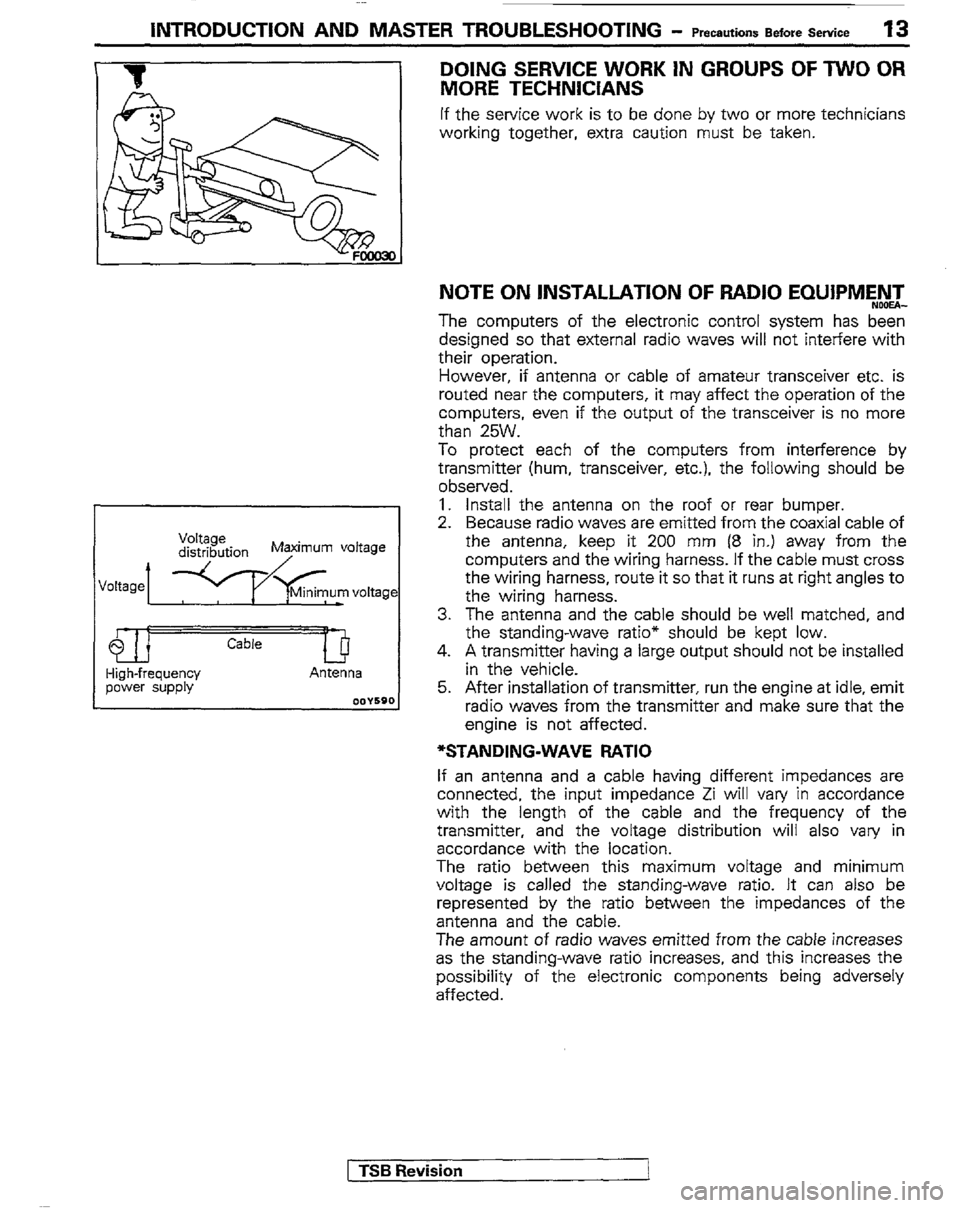Page 13 of 30

INTRODUCTION AND MASTER TROUBLESHOOTING - t+mwtions Before Service ‘I3
DOING SERVICE WORK IN GROUPS OF TWO OR
MORE TECHNICIANS
If the service work is to be done by two or more technicians
working together, extra caution must be taken.
NOTE ON INSTALLATION OF RADIO EQUlPM$ihl-
The computers of the electronic control system has been
designed so that external radio waves will not interfere with
their operation.
However, if antenna or cable of amateur transceiver etc. is
routed near the computers, it may affect the operation of the
computers. even if the output of the transceiver is no more
than 25W.
To protect each of the computers from interference by
transmitter (hum, transceiver, etc.). the following should be
observed.
1. Install the antenna on the roof or rear bumper.
2. Because radio waves are emitted from the coaxial cable of
the antenna, keep it 200 mm (8 in.) away from the
computers and the wiring harness. If the cable must cross
the wiring harness, route it so that it runs at right angles to
the wiring harness.
3. The antenna and the cable should be well matched, and
the standing-wave ratio” should be kept low.
4. A transmitter having a large output should not be installed
in the vehicle.
5. After installation of transmitter, run the engine at idle, emit
radio waves from the transmitter and make sure that the
engine is not affected.
*STANDING-WAVE RATIO
If an antenna and a cable having different impedances are
connected, the input impedance Zi will vary in accordance
with the length of the cable and the frequency of the
transmitter, and the voltage distribution will also vary in
accordance with the location.
The ratio between this maximum voltage and minimum
voltage is called the standing-wave ratio. It can also be
represented by the ratio between the impedances of the
antenna and the cable.
The amount of radio waves emitted from the cable increases
as the standing-wave ratio increases, and this increases the
possibility of the electronic components being adversely
affected.
1 TSB Revision
I
Page 20 of 30

20 INTRODUCTION AND MASTER TROUBLESHOOTING - General Data and Specifications
GENERAL DATA AND SPECIFICATIONS NW-
<2-door vehicles>
Models L047.G
ascription
chicle dimensions mm (in.)
Overall length
Without spare tire 0
With spare tire 8
Overall width @
Overall height
@
Wheelbase c3
Tread Front @
Rear 6
Overhang
Front @
Rear (9,
Height at curb weight (wt.)
Front bumper to ground @
Rear bumperto ground 0
Minimum running ground 0
clearance
Angle of approach 8
Angle of departure 8
Ramp breakover angle -33
hicle weights kg (Ibs.)
Curb weight
Gross vehicle weight rating
Gross axle Front
weight rating
Rear
Seating capacity TNSL F/H
3,900 (153.5)
3,935 (154.9)
1,680 (66.1)
1,840 (72.4)
2,350 (92.5)
1,400 (55.1)
1,375 (54.1)
685 (27.0)
900 (35.4)
480(18.9)
440(17.3)
210(8.3)
38”
28”
21”
1,455 (3.207)
1,910(4.210)
1 ,I 00 (2.425)
1,450 (3.197)
2 T
TNJL F/H
3,905 (153.7)
3,940(155.1)
1,680 (661)
1,850 (72.8)
2,350 (92.5)
1,400 (551)
1,415 (55.7)
685 (27.0)
905 (35.6)
490 (19.3)
450 (17.7)
215 (8.5)
38”
28”
21°
1,585 (3,494)
2,200 (4,850)
1,100 (2,425)
1,600 (3,527)
2 L141G
TRJL F/W
3,905 (153.7)
3,940(155.1)
1,880 (66.1)
1,850 (72.8)
2,350 (92.5)
1,400(55.1)
1,415 (55.7)
685 (27.0)
905 (35.6)
490(19.3)
450(17.7)
215(8.5)
38”
28”
21”
1,600 (3.527)
2,200 (4,850)
1,100 (2,425)
1,600 (3,527)
2 TRUL F/H
3,905 (153.7)
3,940(155.1)
1,680 (66.1)
1,850 (72.8)
2,350 (92.5)
1,400 (55.1)
1,415 (55.7)
685 (27.0)
905 (35.6)
490 (19.3)
450 (17.7)
215 (8.5)
38”
28”
21”
1,605 (3,538)
2,200 (4,850)
1,100 (2,425)
1,600 (3,527)
2
;--- -. . I I TSB Revision
Page 22 of 30

-_-
22 INTRODUCTION AND MASTER TROUBLESHOOTING - General Data and Specifications
<&door vehicles>
L-
chicle dimensions mm (in.)
Overall length
Withoutspare tire a
With spare tire @
Overall width 0
Overall height @
Wheelbase Q
Tread Front @
Rear 8
Overhang Front @
Rear @
Height at curb weight
Wt.)
Front bumperto ground @
Rear bumper to ground 0
Minimum running ground @
clearance
Angle of approach 8
Angle of departure
8
Ramp breakover angle
63
,hicle weights kg (Ibs.)
Curb weight
Gross vehicle weight rating
Gross axle Front
weight rating
Rear
Seating capacity
gine
Model No.
Type
Number of cylinders
Bore
Stroke
Piston displacement
Compression ratio
Firing order
Basic ignition timing VMNJL F/H VMRJL F/H
4,570 (179.9)
4,605 (181.3)
1,680 (66.1)
1,890 (74.4)
2,695 (106.1)
1,400 (55.1)
I,41 5 (55.7)
745 (29.3)
1 ,I 65 (45.9) 4,570 ( 179.9)
4,605(181.3)
1,680 (66.1)
1,890 (74.4)
2,695(106.1)
1.400(55.1)
1,415 (55.7)
745 (29.3)
1,165(45.9)
490 (19.3)
450(17.7)
215 (8.5) 490 (19.3)
450(17.7)
215 (8.5)
38”
28”
18” 38”
28
18”
-i
1,780 (3,924)
2,400 (5,291)
1,100(2,425)
1,600 (3,527)
5 1,795 (3,957)
2,400 (5,291)
1,100(2.425)
1,600 (3,527)
5
6672
V-type, OHC
6
91 .I mm (3.59 in.)
76.0 mm (2.99 in.)
2,972 cm3 (181.4 cu.in.)
8.9
l-2-3-4-5-6
5”BTDC i2” 6672
V-type, OHC
6
91 .l mm (3.59 in.)
76.0 mm (2.99 in.)
2,972 cm3 (181.4 cuin.)
8.9
1-2-3-4-5-6
5”BTDC 22” : L146G
L
_-. 1 TSB Revision I
.- WMRUL F/H
4.570 (179.9)
4,605 (181.3)
1,680 (66.1)
1,890 (74.4)
2,695(106.1)
1,400(55.1)
1,415 (55.7)
745 (29.3)
1,165 (45.9)
490 (19.3)
450 (17.7)
215 (8.5)
38”
28”
18
1,805 (3,979)
2,400 (5,291)
1 ,100 (2,425)
1,600 (3,527)
5
3072
V-type, OHC
3
31 .l mm (3.59 in.)
76.0 mm (2.99 in.)
2,972 cm3 (181.4 cu.in.)
3.9
l-2-3-4-5-6
5”BTDC 22”